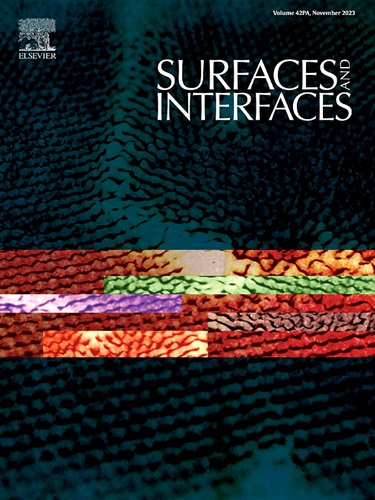Shape controlled synthesis and crystal facet dependent gas sensitivity of tungsten oxide
IF 5.7
2区 材料科学
Q2 CHEMISTRY, PHYSICAL
引用次数: 0
Abstract
Gas sensors can achieve remarkable functionality through the optimization of particle size, shapes, crystal facets, and oxygen defects, resulting in unsaturated coordination atoms, high charge densities, and enhanced bond energies. In this study, WO2.72 nanourchins, WO3-x nanowires, and WO3 nanorods/nanocube with (010), (001), (200), and (002) dominant crystal facets were synthesized and used as gas sensing materials. It was found that WO2.72 nanourchins exhibit an excellent response of Ra/Rg=21 to 100 ppm acetone with good selectivity among other sensors as-fabricated. First-principle calculations of Density Functional Theory were performed on acetone's adsorption on different crystal planes of tungsten oxide. The results verify spontaneous and fast adsorption on the (010) crystal plane than on the (001) and (200) planes. Further characterizations indicate that WO2.72 nanourchins with (010) crystal facets contain more reactive sites with high surface energy, facilitating charge separation, increasing charge carrier mobility, and enabling the redox reactions to occur independently at different rates. Moreover, their richer electron-donor surface oxygen defects, smaller feature sizes, and higher surface area (SBET) with hierarchical porous structures, all contribute to the enhanced acetone sensing. Our work provides a strategy for improved acetone sensing based on optimizing the particle shape with different crystal facets and oxygen vacancy density. We further expect our strategy to be applicable in designing other sensor materials with efficient charge separation and fast surface redox reactions to detect toxic gases.

氧化钨的形状控制合成和晶体面依赖性气体灵敏度
通过优化粒度、形状、晶面和氧缺陷,产生不饱和配位原子、高电荷密度和增强键能,气体传感器可以实现卓越的功能。本研究合成了具有 (010)、(001)、(200) 和 (002) 优势晶面的 WO2.72 纳米络素、WO3-x 纳米线和 WO3 纳米棒/纳米立方体,并将其用作气体传感材料。研究发现,WO2.72 纳米硬质合金对 100 ppm 丙酮的响应为 Ra/Rg=21 ,在其他已制成的传感器中具有良好的选择性。对丙酮在氧化钨不同晶面上的吸附进行了密度泛函理论的第一原理计算。结果表明,与 (001) 和 (200) 晶面相比,(010) 晶面上的丙酮自发吸附速度更快。进一步的表征结果表明,具有 (010) 晶面的 WO2.72 纳米氧化钨含有更多具有高表面能的反应位点,有利于电荷分离,提高电荷载流子的迁移率,并使氧化还原反应以不同的速率独立进行。此外,它们具有更丰富的电子供体表面氧缺陷、更小的特征尺寸和更高的比表面积(SBET)以及分层多孔结构,这些都有助于增强丙酮传感能力。我们的工作提供了一种基于优化不同晶面和氧空位密度的颗粒形状来改进丙酮传感的策略。我们还期望我们的策略能适用于设计其他具有高效电荷分离和快速表面氧化还原反应的传感器材料,以检测有毒气体。
本文章由计算机程序翻译,如有差异,请以英文原文为准。
求助全文
约1分钟内获得全文
求助全文
来源期刊

Surfaces and Interfaces
Chemistry-General Chemistry
CiteScore
8.50
自引率
6.50%
发文量
753
审稿时长
35 days
期刊介绍:
The aim of the journal is to provide a respectful outlet for ''sound science'' papers in all research areas on surfaces and interfaces. We define sound science papers as papers that describe new and well-executed research, but that do not necessarily provide brand new insights or are merely a description of research results.
Surfaces and Interfaces publishes research papers in all fields of surface science which may not always find the right home on first submission to our Elsevier sister journals (Applied Surface, Surface and Coatings Technology, Thin Solid Films)
 求助内容:
求助内容: 应助结果提醒方式:
应助结果提醒方式:


